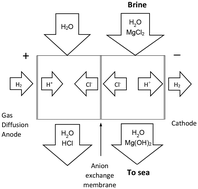Desalination as a negative emissions technology
Abstract
To limit global warming, governments and industries are engaged in reducing emissions of CO2. There is increasing evidence, however, that it may be necessary to go a step further by removing CO2 already emitted. For the purpose of carbon dioxide removal (CDR), a number of negative emissions technologies (NET) have been proposed. These generally make extensive usage of land, energy and water – if they are to be implemented at the large scales needed. It is therefore important to seek, investigate and compare alternative approaches to NET. Desalination plants, though normally seen as sources rather than sinks of CO2, could be modified to provide a new type of NET. In this study, we propose treating desalination reject brine by electrolysis to form Mg(OH)2 and thus absorb CO2via the oceans. The energy and water penalties associated with the electrolysis are calculated as 1.8 GJ per tCO2 and 13.7 m3 per tCO2 respectively, making it an interesting option in comparison with some other types of NET. However, NET-modification more than doubles the specific energy consumption of a reverse-osmosis desalination plant. It is concluded that NET-desalination has potential to contribute to CDR in arid countries (especially if solar energy is used) thus helping to meet Intended Nationally Determined Contributions (INDCs) following the COP21 summit.



 Please wait while we load your content...
Please wait while we load your content...